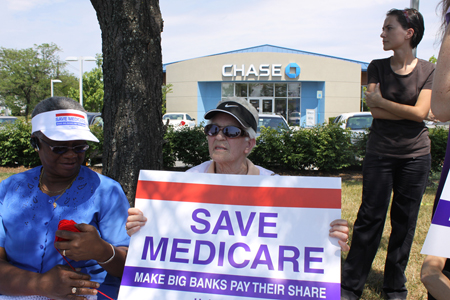| << Chapter < Page | Chapter >> Page > |

Theorists working the conflict perspective view society as inherently unstable, an institution that privileges the powerful wealthy few while marginalizing everyone else. According to the guiding principle of conflict theory, social groups compete with other groups for power and scarce resources. Applied to society’s aging population, the principle means that the elderly struggle with other groups—for example, younger society members—to retain a certain share of resources. At some point, this competition may become conflict.
For example, some people complain that the elderly get more than their fair share of society’s resources. In hard economic times, there is great concern about the huge costs of Social Security and Medicare. One of every four tax dollars, or about 28 percent, is spent on these two programs. In 1950, the federal government paid $781 million in Social Security payments. Now, the payments are 870 times higher. In 2008, the government paid $296 billion (Statistical Abstract 2011). The medical bills of the nation’s elderly population are rising dramatically. While there is more care available to certain segments of the senior community, it must be noted that the financial resources available to the aging can vary tremendously by race, social class, and gender.
There are three classic theories of aging within the conflict perspective. Modernization theory (Cowgill and Holmes 1972) suggests that the primary cause of the elderly losing power and influence in society are the parallel forces of industrialization and modernization. As societies modernize, the status of elders decreases, and they are increasingly likely to experience social exclusion. Before industrialization, strong social norms bound the younger generation to care for the older. Now, as societies industrialize, the nuclear family replaces the extended family. Societies become increasingly individualistic, and norms regarding the care of older people change. In an individualistic industrial society, caring for an elderly relative is seen as a voluntary obligation that may be ignored without fear of social censure.
The central reasoning of modernization theory is that as long as the extended family is the standard family, as in preindustrial economies, elders will have a place in society and a clearly defined role. As societies modernize, the elderly, unable to work outside of the home, have less to offer economically and are seen as a burden. This model may be applied to both the developed and the developing world, and it suggests that as people age they will be abandoned and lose much of their familial support since they become a nonproductive economic burden.
Another theory in the conflict perspective is age stratification theory (Riley, Johnson, and Foner 1972). Though it may seem obvious now, with our awareness of ageism, age stratification theorists were the first to suggest that members of society might be stratified by age, just as they are stratified by race, class, and gender. Because age serves as a basis of social control, different age groups will have varying access to social resources such as political and economic power. Within societies, behavioral age norms, including norms about roles and appropriate behavior, dictate what members of age cohorts may reasonably do. For example, it might be considered deviant for an elderly woman to wear a bikini because it violates norms denying the sexuality of older females. These norms are specific to each age strata, developing from culturally based ideas about how people should “act their age.”

Notification Switch
Would you like to follow the 'Introduction to sociology 2e' conversation and receive update notifications?